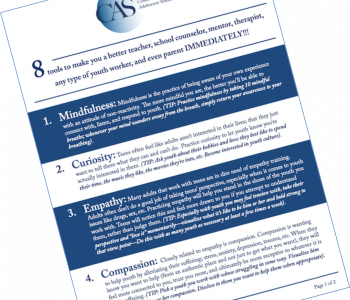

catharine hannay, ma
Catharine Hannay is the founder of MindfulTeachers.org and the author of Being You: A Girl’s Guide to Mindfulness, a workbook for teen girls on mindfulness, compassion, and self-acceptance.
Add a Culturally-Aware Lens to Your Trauma-Informed Toolkit
One year on February 14th, my husband did something utterly baffling. He bought me flowers.
As everybody knows, women are supposed to buy men chocolate on Valentine’s Day, and men reciprocate a month later on White Day.
At least, everyone knows this in Osaka, which is where we were living at the time.
I sometimes define culture as ‘what a particular group takes for granted’. We’re often not aware of how influenced we are by our own culture until something happens that challenges our assumptions.
When working with youth whose background is different from ours, it’s important to ask ourselves what might be happening from their point of view. The following questions can help you add a culturally-informed lens to your trauma-informed toolkit.
Do I need to explain something ‘obvious’?
A young man was standing in the corner of the room staring at something at the end of the conference table. He looked quite confused and mildly disgusted, so I hurried over to see what was wrong.
“What,” he asked me, “is this strange food?”
It was an odd-looking substance indeed, very dark brown with a thin layer of faded, crinkled brown on top. No wonder he was having second thoughts about participating in the international potluck lunch.
After I explained what it was and took a bite myself, he was willing to give it a nibble, and he agreed that it was unexpectedly tasty. But I could understand why someone who’d never seen such a thing before would be reluctant to try a brownie.
Is this a cultural issue, an emotional response, or simply pushing boundaries?
Sometimes adults become even angrier when kids respond to a reprimand by giggling, smiling, or not making eye contact. Depending on the youth’s country of origin, these could all actually be signs of respect toward a person in authority.
On the other hand, not every sort of inappropriate behavior can be attributed to culture, just as not every incident of aggression is necessarily a trauma response.
When you’re not sure what’s going on, it can be helpful to look for micro-expressions, those lightning-quick moments when we reveal our true feelings. A few examples are:
- A flash of anger before a polite smile.
- A moment of fear before an aggressive outburst.
- A crafty smirk before innocent puppy dog eyes.
What culture(s) do I belong to? Do I represent a group this youth has had issues with in the past?
When I’ve lived and traveled overseas, I’ve sometimes been surprised by what people assume about me because I’m American. Even here in the U.S., there’s sometimes a negative view of me based on my age, race, and gender. Not that anyone seems to feel particularly threatened by middle-aged white ladies, but we can be viewed with suspicion by young people who’ve had previous negative experiences.
On my way home from work one afternoon, I smiled at the young mother and son sitting across from me on the bus and asked, “Are you going to the zoo?”
“Yeah,” the mother said. “We be goin’—“
She paused and looked me in the eye before very slowly and clearly enunciating “Yes, we are going to the zoo.”
Point taken. She was perfectly capable of speaking like me if she wanted to, and was making a choice to speak in a different way to her child.
It was an interesting moment, related to her assumptions about my assumptions about the way she was speaking.
As sensitive as we try to be, the youth we work with aren’t just experiencing us, they’re filtering whatever we say or do through their previous experiences with members of our group. And this might be a group we don’t even consciously belong to. For example, I never thought of myself as a ‘westerner’ before I lived in Asia. And I never thought of myself as a ‘hearing person’ until I worked on a project where I was the only one who couldn’t communicate in sign language.
Is this youth caught between two cultures?
First generation, second generation, and ‘generation 1.5’ immigrants are often caught between a rock and a hard place, with very different expectations at home and at school.
One of my students was absent from class for several days because his grandfather died. The school didn’t consider this an excused absence, but he felt like he didn’t have a choice. Although barely twenty, he was the oldest living male descendant of the man who died and therefore had tremendous responsibilities within the family.
Is there a language issue, as well?
Trauma and culture shock can make it even harder to communicate in a second language. This is captured in a moving passage from the novel The Translation of Love, by Lynne Kutsukake.
Aya is a young girl who was born and raised in Canada by Japanese parents, then held in an internment camp during the war. After her mother dies, she and her father ‘repatriate’ to occupied Japan, where she struggles to make sense of her new life.
Sometimes Aya understood, often she didn’t. It seemed to depend less on what people said than on how. If they spoke to her slowly and gently, the way her mother always had, then the words were like drops of warm rain that dissolved magically into her brain, and she understood every single word… Hardly anyone here spoke like [that]. Everyone was in too much of a hurry… so cross and impatient that it was impossible to understand them. Their words swirled around and around, circling her head like angry black crows.
[For more about working with non-native speakers, see “Three Essential Tips for Working with Limited English Proficiency Youth.”]
Do I appear more threatening than I realize?
For a youth who’s simultaneously dealing with trauma and culture shock, even something as seemingly innocuous as raising your voice may be perceived as far more aggressive than you intend it to.
If you wear any type of uniform, you could be quite frightening to a kid who’s had negative experiences with military personnel or law enforcement.
And if you’re male, keep in mind that women and girls from any culture may have been threatened or assaulted. Especially if you work with refugees, don’t forget that rape is used in many parts of the world as a weapon of war or as a means of torturing political prisoners, and it’s very common in refugee camps and along smuggling routes.
Even if you’re a sweet teddy bear of a guy, a traumatized young woman could easily mistake you for a grizzly bear.
How can I help if I don’t know what’s wrong?
Start by taking a step back. Literally, physically take a step away from a youth who’s upset, rather than reaching toward him or her with the intention to comfort. Then try ‘T.A.P., a relational mindfulness practice developed by Dr. Sam Himelstein:
Take a breath. Acknowledge.
Proceed.
I can’t guarantee that this approach will work in every situation, but I can assure you that it worked for a friend of mine while he was at university.
He tried putting his arm around a girl in a friendly, brotherly manner, and was surprised when she jerked away from him. When he tried asking what was wrong, she stared at him without speaking, then shoved past him and left the room.
He had no idea what was going on, but he could tell something was very wrong.
He then:
- Took a couple of deep breaths
- Acknowledged to himself that he was hurt and confused. He also acknowledged that, regardless of his intent, the girl was frightened.
- Got out of her way and let her leave the room. Then he sent her a message expressing concern and suggesting they meet in a well-lit, well-traveled part of campus.
When we met (yes, the girl was me), I explained that something in what he said and the way he moved toward me triggered a flashback to an incident that happened a few years earlier.
First, I froze. When he asked me what was wrong, I was so freaked out I couldn’t speak. Then, my ‘flight’ instinct kicked in, and I desperately needed to get out of the room.
Unfortunately, as he was trying to figure out what was going on, he kept moving the same direction I was going, so he kept positioning himself between me and the door. That’s when my ‘fight’ instinct took over, and I shoved past him to reach the exit.
While his intentions were friendly, he could understand why I misinterpreted them based on my previous experience. He also hadn’t realized that his culture had quite different standards than mine of appropriate friendly touch. The intersection between trauma response and different cultural assumptions meant that he was confused while I was terrified.
Conclusion
A culturally-aware lens, like a trauma-informed lens, means always keeping in mind that such issues could be a possibility. Above all, it means giving our students and clients the benefit of the doubt. When youth seem to be overreacting, or their behavior seems odd or offensive, what could be the motivation behind it? Could this behavior be related to a cultural difference? Could it be a response to trauma? Is there some other factor I’m not aware of?
The more questions we ask, the better we can understand the youth we work with, which will make any help we offer much more effective. We may still not have all the answers, but we can at least listen with an open mind and an open heart.
—
Catharine Hannay (MA TESOL, MS Communications) has twenty years of experience teaching non-native speakers of English, including a dozen years at Georgetown University’s Center for Language Education and Development. She is the founder and editor of MindfulTeachers.org, which provides free resources on mindfulness and self-care for educators and other helping professionals.
Learn more about the T. A. P. technique in both the Building Authentic Relationships (BARs) and the Trauma-Informed Care for Professionals Working with Youth online courses.
Related Posts
How Can I Better Support Immigrant and Refugee Youth?
4 Tips for Culturally-Sensitive Teaching

